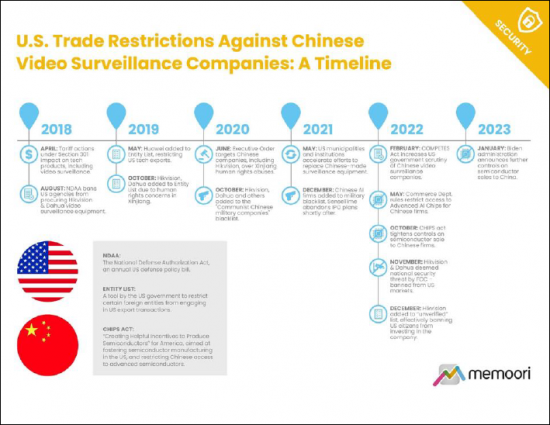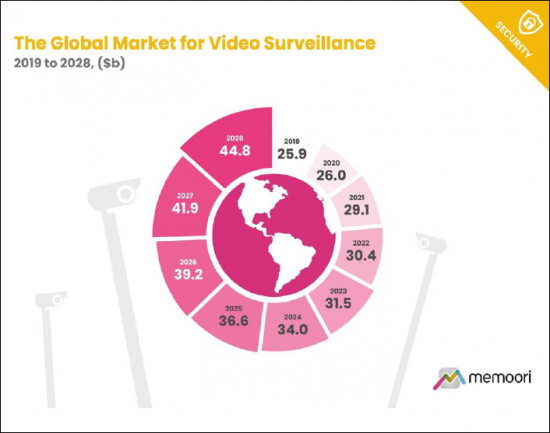|
|
市場調査レポート
商品コード
1357223
ビデオ監視の世界市場(2023年~2028年)The Global Video Surveillance Business 2023 to 2028 |
||||||
|
|||||||
| ビデオ監視の世界市場(2023年~2028年) |
|
出版日: 2023年09月30日
発行: Memoori
ページ情報: 英文 219 Pages, 19 Charts, Spreadsheet, In-Depth Company Profiles, Presentation Slides
納期: 即日から翌営業日
|
- 全表示
- 概要
- 図表
- 目次
- 世界のビデオ監視機器とソフトウェアの収益(FGP)は、2022年に推定304億米ドルに達しました。これは、パンデミックの影響を受けた2021年の11.7%の回復よりは低いですが、2021年比で4.5%の健全な成長です。2028年までに448億米ドルに達し、2022年~2028年にCAGRで5.7%の拡大が予測されています。
- 市場では過去2~3年間に、エッジ処理が可能なAI対応カメラの採用が大きく急増しています。最新の予測では、AI機能を内蔵して出荷されるネットワークセキュリティカメラの割合は、2022年の約18%から着実に上昇し、2028年までに50%を超える見込みです。
- 世界のビデオ監視ソリューションの需要拡大に拍車をかけているのは、いくつかの連動した要因です。犯罪やテロリストの脅威の拡大により、公共機関も民間機関もセキュリティモニタリングの強化を余儀なくされています。しかし、ビデオ監視産業は、パンデミックの回復中にサプライチェーンの混乱、製品の不足、コストのインフレに直面しました。特に半導体のような主要コンポーネントでは、需要の急増がメーカーの生産能力を上回っています。
中国と欧米の地政学的緊張が市場を刺激し、特に中国の主要ベンダーであるHikvisionとDahuaに影響を与えています。米国は、政府機関による機器の購入を禁止しており、輸出規制によって米国の技術へのアクセスや米国の資本市場への参入が制限されています。米国とその同盟国は、データセキュリティ、人権問題、知的財産慣行に関する懸念を理由としています。

当レポートでは、世界のビデオ監視市場について調査分析し、市場の規模と構造、主な成長促進要因、合併・買収・投資の影響など、市場の現状と将来の予測を提供しています。
目次
序文
エグゼクティブサマリー
第1章 ビデオ監視ビジネスの構造と形態
- ビデオ監視市場の構造
- 企業の分類と市場シェア
- 市場力学(ポーターのファイブフォース分析)
- 販売/流通チャネル
第2章 ビデオ監視市場
- ビデオ監視の採用と投資
- 市場の経営状況
- 主な採用の促進要因
- 物理セキュリティの支出計画と予算
- ビデオ監視の市場規模と成長予測
- 市場規模、成長、動向:主要地域別
- 北米
- ラテンアメリカ・カリブ海
- 中国
- その他のアジア太平洋
- 欧州
- 中東・アフリカ
- 市場規模と動向:産業別
- オフィス
- 医療
- 教育
- 小売
- ホスピタリティ
- 工業
- 公共インフラ・都市監視
- データセンター
- 輸送
- ビデオカメラ
- ビデオ監視カメラ
- 市場規模と成長動向
- 市場力学
- 主要企業とベンダー情勢
- 身体装着型カメラ
- 市場規模と成長動向
- 市場力学
- 主要企業とベンダー情勢
- サーマルカメラ
- 市場規模と成長動向
- 市場力学
- 主要企業とベンダー情勢
- ビデオ監視ソフトウェア・アナリティクス
- 市場規模と成長動向
- 市場力学
- 主要企業とベンダー情勢
- VSaaS・クラウド
- 市場力学
- VSaaSのビジネスモデルと競合情勢
- 技術と運用上の考察
- コストと規制要因
- ビデオストレージハードウェア・サービス
- 市場規模と成長動向
- 市場力学
- 主要企業とベンダー情勢
第3章 IP接続・IoT
- IPとIoTの融合
- IoT対応ビデオ監視の利点
- IoTの成長と採用の動向
- IoTの採用に伴う課題
- システムインテグレーターの役割
第4章 AIと機械学習
- 市場の成長と採用
- 用途と使用事例
- セーフティ・セキュリティ関連用途
- より広範な利益をもたらす追加の用途
- エンコード・圧縮
- エッジデバイスとハードウェアイネーブラー
- ハードウェアイネーブラー:AIチップ、AI NVR、AIカメラ
- AIチップ
- AIネットワークビデオレコーダー(NVR)
- AIカメラ
- AIベンダー情勢
- 新製品のリリース
第5章 無線・セルラー技術
- 無線伝送方式
- 4G
- Wi-Fi
- 5G
- プライベートLTE/5Gネットワーク
- 主な利点
- 無線に対する課題と考慮事項
- 5Gの潜在的な使用事例
- 無線・5Gカメラ
- 無線
- 5G
第6章 その他の注目すべき技術の促進要因
- 画質/解像度
- 市場の採用と進化
- 用途固有の解像度要件
- 技術の考慮事項
- 低照度/赤外線/ナイトビジョン
- 超低照度カメラ技術
- 統合型IRカメラの技術と用途
- 特殊な低照度カメラ
- マルチセンサーデバイス
- 概要と利点
- 市場の採用と進化
- 技術の考慮事項
- 先進脅威検出システム
- イントロダクションと特殊な脅威検出カテゴリ
- 市場び促進要因と力学
- 注目のベンダーと市場の製品
- 統合・相互運用性
- 相互運用性の利点
- オープンプラットフォームへの進化
- ONVIF規格
- ビデオ監視、物理セキュリティ、ビルディングシステムの統合
第7章 地政学的緊張と貿易障壁
- 米国/中国の動向
- 将来の米国の規制の可能性
- 中国政府による相互の貿易制限
- その他の貿易障壁:国別、地域別
- 貿易障壁の影響
- ウクライナ戦争
第8章 サプライチェーンの動向
- パンデミックの影響の振り返り
- コストの上昇が企業の利益を圧迫する
- ビデオ監視サプライチェーンの現状
- 将来に向けたサプライチェーンのレジリエンスの構築
第9章 持続可能性
- ビデオ監視システムの環境に対する影響
- メーカーの持続可能性への取り組みとコミットメント
- サステナビリティへの取り組みに向けた動画の活用
- 回復力と将来性のある監視システムの開発
第10章 スキル、才能、労働力
- 主な課題
- 新たな機会
第11章 サイバーセキュリティ
- 主な脅威と脆弱性
- 重大なサイバーセキュリティインシデント
- サプライチェーンリスク
- 規制とコンプライアンス
- 侵害と脆弱性の開示
- 軽減のベストプラクティス
第12章 データプライバシーと倫理
- プライバシーへの配慮
- プライバシー規定
- 顔認識の課題と規制
- 倫理的実装とAIバイアス
第13章 合併と買収
- 物理セキュリティ市場におけるM&Aの実績
- 2018年以降の主なM&A取引
- 2022年9月末までの主な取引
- 2023年9月末までのM&A取引
- M&Aの動向とその影響
第14章 戦略的提携
- 物理セキュリティ市場における過去の戦略的提携
- 2023年9月末までの新規の戦略的提携
- 戦略的提携の動向とその影響
第15章 投資の動向
- 投資の力学
- 2022年9月末までの主な取引
- 2023年9月末までの投資取引
- 投資の動向の考察と意味するもの
List of Charts and Figures
- Fig 1.1 - Video Surveillance Market Structure
- Fig 1.2 - Video Surveillance Sales by Major Grouping, Number of Companies, % of Global Sales in 2022
- Fig 1.3 - Market Share of Global Video Surveillance Sales by Major Vendor 2022
- Fig 1.4 - Average Revenue for Group A, B, C & D Companies
- Fig 1.5 - Video Surveillance Market: Porter's Five Forces Analysis
- Fig 2.1 - The Security Market Index (SMI)
- Fig 2.2 - The Global Market for Video Surveillance 2019 to 2028 ($b)
- Fig 2.3 - The Global Market for Video Surveillance by Category 2019 to 2028 ($b)
- Fig 2.4 - Video Surveillance Sales by Region in 2022
- Fig 2.5 - Video Surveillance Sales by Region 2019 to 2028 ($b)
- Fig 2.6 - Estimated Distribution of Video Surveillance Solutions by Building Type in 2023
- Fig 2.7 - Global Sales of Video Surveillance Cameras by Type 2019 to 2028 ($b)
- Fig 2.8 - Global Video Surveillance Camera Market - Analog and IP Camera Market Share 2019 to 2028
- Fig 2.9 - Global Sales of Video Management Software (VMS) & Analytics 2019 to 2028 ($b)
- Fig 2.10 - Global Sales of Video Storage Hardware & Services 2019 to 2028 ($b)
- Fig 4.1 - Global AI Video Surveillance Camera Shipments, % of Overall Video Surveillance Camera Shipments 2022 to 2028
- Fig 7.1 - US Trade Restrictions Against Chinese Video Surveillance Companies: A Timeline
- Fig 13.1 - Security Deals Completed from 2002 to 2022, Estimated Total Value of Deals ($m)
- Fig 14.1 - Strategic Alliances 2008 to 2023
This report is an in-depth study providing a detailed market analysis of video surveillance, with a specific focus on revenues generated by cameras, video storage, software & analytics.
It is a comprehensive overview of the current and anticipated landscape of the video surveillance market. Drawing on in-depth expertise in the fields of Physical Security, IoT, Cyber Security, and Artificial Intelligence, our analysis aims to empower professionals across the industry - from manufacturers to system integrators, from security consultants to end-users.
This report is the first instalment of a two-part series covering Physical Security Technology. Part 2, covering Access Control Systems, is to be published later in Q4 2023. Both these reports are included in “Memoori's 2023 Premium Subscription Service”.
Key Questions Addressed:
- What is the size and structure of the global video surveillance market? How is the market broken down into cameras, storage, software and analytics? Where are the dominant geographic markets in the world? How are sales split between 16 different industry verticals?
- What are the main drivers for industry growth? How will the market grow over the next 5 years? Which technologies are helping to reshape this market and create new business models?
- How are mergers, acquisitions and investments impacting the industry? How does acquisition activity stack up against previous years both in terms of value and volume? How much investment has the market attracted from venture capital and private equity this year?

Within its 219 Pages and 19 Charts, This Report Presents All the Key Facts and Draws Conclusions, so you can understand what is Shaping the Future of the Video Surveillance Industry:
- Total global revenues for video surveillance equipment and software at factory gate prices, reached an estimated $30.4 billion in 2022. This represents healthy 4.5% growth over 2021, albeit lower than the 11.7% rebound in 2021 following pandemic impacts. For the 6-year period between 2022-2028, the market is projected to expand at a 5.7% CAGR, reaching $44.8 billion by 2028.
- The market has seen a major surge in the adoption of AI-enabled cameras capable of edge processing over the past 2-3 years. These cameras come equipped with various AI-powered functionalities, ranging from basic facial recognition in low-end models to more advanced capabilities like 4K resolution, object classification, behaviour analysis and people tracking in high-end models. Our latest estimates forecast that the percentage of network security cameras shipping with built-in AI capabilities will rise steadily from around 18% in 2022 to over 50% by 2028.
- Several interlinked factors are fueling strong demand growth globally for video surveillance solutions. Expanding criminal and terrorist threats have compelled both public and private entities to ramp up security monitoring. However, the video surveillance industry has faced significant supply chain disruptions, product shortages, and cost inflation during the pandemic recovery. Surging demand has outstripped manufacturers' production capacity, especially for key components like semiconductors.
This report provides valuable information into how physical security companies can develop their business strategy through mergers, acquisitions, and alliances.
Geopolitical tensions between China and the West have stirred up the video surveillance market, especially impacting leading Chinese vendors Hikvision and Dahua. US bans prohibit government agencies from purchasing their equipment, while export controls limit access to American technology and participation in US capital markets. The US and its allies cite concerns around data security, human rights controversies, and intellectual property practices.

M&A trends point toward increased competition for small vendors, a pivot from hardware to software, the rise of intelligent video, acceleration of cloud adoption, simplified integrated security offerings, and the competitive advantage of global scale.
Investment trends reveal a focus on both scaling mature firms and investing in disruptive startups. Priorities include AI, cloud migration, geographic expansion, and regulatory adaptability. The market remains open to innovation but cautious given economic conditions.
Who Should Buy This Report?
The information in this report will be of value to all those engaged in managing, operating, and investing in electronic security technology companies (and their advisors) around the world. In particular, those wishing to acquire, merge or sell companies will find its contents particularly useful. Want to know more?
Table of Contents
Preface
Executive Summary
1. The Structure & Shape of the Video Surveillance Business
- 1.1. Video Surveillance Market Structure
- 1.2. Company Classifications & Market Share
- 1.3. Market Dynamics (Porter's Five Forces Analysis)
- 1.4. Sales & Distribution Channels
2. The Video Surveillance Market
- 2.1. Video Surveillance Adoption & Investment
- 2.1.1. Market Operation Conditions
- 2.1.2. Key Adoption Drivers
- 2.1.3. Physical Security Spending Plans & Budgets
- 2.2. Video Surveillance Market Size & Growth Forecasts
- 2.3. Market Size, Growth & Trends by Major Region
- 2.3.1. North America
- 2.3.2. Latin America & The Caribbean
- 2.3.3. China
- 2.3.4. The Rest of Asia Pacific
- 2.3.5. Europe
- 2.3.6. Middle East & Africa
- 2.4. Market Size & Trends by Vertical
- 2.4.1. Offices
- 2.4.2. Healthcare
- 2.4.3. Education
- 2.4.4. Retail
- 2.4.5. Hospitality
- 2.4.6. Industrial
- 2.4.7. Public Infrastructure & City Surveillance
- 2.4.8. Data Centers
- 2.4.9. Transportation
- 2.5. Video Cameras
- 2.6. Video Surveillance Cameras
- 2.6.1. Market Size & Growth Trends
- 2.6.2. Market Dynamics
- 2.6.3. Key Players & Vendor Landscape
- 2.7. Body Worn Cameras
- 2.7.1. Market Size & Growth Trends
- 2.7.2. Market Dynamics
- 2.7.3. Key Players & Vendor Landscape
- 2.8. Thermal Cameras
- 2.8.1. Market Size & Growth Trends
- 2.8.2. Market Dynamics
- 2.8.3. Key Players & Vendor Landscape
- 2.9. Video Surveillance Software & Analytics
- 2.9.1. Market Size & Growth Trends
- 2.9.2. Market Dynamics
- 2.9.3. Key Players & Vendor Landscape
- 2.10. VSaaS & Cloud
- 2.10.1. Market Dynamics
- 2.10.2. VSaaS Business Models and Competitive Landscape
- 2.10.3. Technology and Operational Insights
- 2.10.4. Cost and Regulatory Factors
- 2.11. Video Storage Hardware & Services
- 2.11.1. Market Size & Growth Trends
- 2.11.2. Market Dynamics
- 2.11.3. Key Players & Vendor Landscape
3. IP Connectivity & the IoT
- 3.1. The Convergence of IP and IoT
- 3.2. The Benefits of IoT-Enabled Video Surveillance
- 3.3. IoT Growth & Adoption Trends
- 3.4. Challenges Associated with IoT Adoption
- 3.5. The Role of Systems Integrators
4. AI & Machine Learning
- 4.1. Market Growth & Adoption
- 4.2. Applications & Use Cases
- 4.2.1. Safety and Security-Related Applications
- 4.2.2. Additional Applications Providing Wider Benefits
- 4.2.3. Encoding & Compression
- 4.3. Edge Devices and Hardware Enablers
- 4.4. Hardware Enablers: AI Chips, AI NVRs, and AI Cameras
- 4.1.1. AI Chips
- 4.4.2. AI Network Video Recorders (NVRs)
- 4.4.3. AI Cameras
- 4.5. The AI Vendor Landscape
- 4.6. New Product Releases
5. Wireless & Cellular Technology
- 5.1. Wireless Transmission Methods
- 5.1.1. 4G
- 5.1.2. WiFi
- 5.1.3. 5G
- 5.1.4. Private LTE/5G Networks
- 5.2. Key Benefits
- 5.3. Challenges & Considerations for Wireless
- 5.4. Potential Use Cases for 5G
- 5.5. Wireless & 5G Cameras
- 5.5.1. Wireless
- 5.5.2. 5G
6. Other Notable Technology Drivers
- 6.1. Image Quality / Resolution
- 6.1.1. Market Adoption and Evolution
- 6.1.2. Application-Specific Resolution Requirements
- 6.1.3. Technical Considerations
- 6.2. Low Light / Infra-Red / Night Vision
- 6.2.1. Super Low Light Camera Technology
- 6.2.2. Integrated IR Camera Technology and Applications
- 6.2.3. Speciality Low Light Cameras
- 6.3. Multi-Sensor Devices
- 6.3.1. Overview and Benefits
- 6.3.2. Market Adoption & Evolution
- 6.3.3. Technical Considerations
- 6.4. Advanced Threat Detection Systems
- 6.4.1. Introduction and Specialized Threat Detection Categories
- 6.4.2. Market Drivers & Dynamics
- 6.4.3. Notable Vendors & Market Offerings
- 6.5. Integration & Interoperability
- 6.5.1. Benefits of Interoperability
- 6.5.2. The Evolution Towards Open Platforms
- 6.5.3. ONVIF Standards
- 6.5.4. Integration Between Video Surveillance, Physical Security and Building Systems
7. Geopolitical Tensions & Trade Barriers
- 7.1. US/China Dynamics
- 7.1.1. Potential Future US Restrictions
- 7.1.2. Reciprocal Chinese Government Trade Restrictions
- 7.2. Trade Barriers by Other Countries and Regions
- 7.3. Implications of Trade Barriers
- 7.3.1. Impact on Chinese Manufacturers
- 7.3.2. Strategic Responses of Chinese Manufacturers
- 7.3.3. The Realities of Trading in China for non-Chinese firms
- 7.3.4. Corporate Responses to Chinese Video Surveillance Controversies
- 7.3.5. Implications for Non-Chinese Vendors
- 7.3.6. Long-Term Impacts on Global Supply Chains
- 7.3.7. Potential for New Competitors
- 7.3.8. Uncertain Future Direction
- 7.4. The War in Ukraine
8. Supply Chain Trends
- 8.1. A Retrospective of Pandemic Impacts
- 8.2. Rising Costs Squeeze Company Margins
- 8.3. The Current State of Video Surveillance Supply Chains
- 8.4. Building Supply Chain Resilience for the Future
9. Sustainability
- 9.1. The Environmental Impact of Video Surveillance Systems
- 9.2. Manufacturers' Sustainability Efforts and Commitments
- 9.3. Leveraging Video for Sustainability Initiatives
- 9.4. Developing Resilient and Future-Proof Surveillance Systems
10. Skills, Talent & Labor
- 10.1. Key Challenges
- 10.2. Emerging Opportunities
11. Cybersecurity
- 11.1. Key Threats and Vulnerabilities
- 11.2. Major Cybersecurity Incidents
- 11.3. Supply Chain Risks
- 11.4. Regulations and Compliance
- 11.5. Breach & Vulnerability Disclosure
- 11.6. Mitigation Best Practices
12. Data Privacy & Ethics
- 12.1. Privacy Considerations
- 12.2. Privacy Regulations
- 12.3. Facial Recognition Challenges & Regulations
- 12.4. Ethical Implementation and AI Bias
13. Mergers & Acquisitions
- 13.1. Historic M&A Performance in the Physical Security Market
- 13.2. Key M&A Deals Since 2018
- 13.3. Key Deals to the end of September 2022
- 13.4. M&A Deals to the end of September 2023
- 13.5. M&A Trends and Implications
- 13.5.1. Notable Trends
- 13.5.2. Implications
14. Strategic Alliances
- 14.1. Historic Strategic Alliances in the Physical Security Market
- 14.2. New Strategic Alliances to the end of September 2023
- 14.3. Strategic Alliance Trends and Implications
15. Investment Trends
- 15.1. Investment Dynamics
- 15.2. Key Deals to the end of September 2022
- 15.3. Investment Deals to the end of September 2023
- 15.4. Investment Trend Observations & Implications






